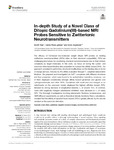Mostrar o rexistro simple do ítem
In-depth study of a novel class of ditopic gadolinium(III)-based MRI probes sensitive to zwitterionic neurotransmitters
| dc.contributor.author | Toljic, Djordje | |
| dc.contributor.author | Platas-Iglesias, Carlos | |
| dc.contributor.author | Angelovski, Goran | |
| dc.date.accessioned | 2019-09-16T10:21:06Z | |
| dc.date.available | 2019-09-16T10:21:06Z | |
| dc.date.issued | 2019-07-24 | |
| dc.identifier.citation | Toljic D, Platas-Iglesias C and Angelovski G (2019) In-depth Study of a Novel Class of Ditopic Gadolinium(III)-based MRI Probes Sensitive to Zwitterionic Neurotransmitters. Front. Chem. 7:490. doi: 10.3389/fchem.2019.00490 | es_ES |
| dc.identifier.issn | 2296-2646 | |
| dc.identifier.uri | http://hdl.handle.net/2183/23940 | |
| dc.description.abstract | [Abstract] The efficacy of Gd-based low-molecular weight ditopic MRI probes on binding zwitterionic neurotransmitters (ZNTs) relies on their structural compatibility. ZNTs are challenging biomarkers for monitoring chemical neurotransmission due to their intrinsic complexity as target molecules. In this work, we focus on tuning the cyclen- and azacrown ether-based binding sites properties to increase the affinity toward ZNTs. Our approach consisted in performing structural modifications on the binding sites in terms of charge and size, followed by the affinity evaluation through T1-weighted relaxometric titrations. We prepared and investigated six Gd3+ complexes with different structures and thus properties, which were found to be acetylcholine insensitive; moreover, two of them displayed considerably stronger affinity toward glutamate and glycine over hydrogencarbonate and other ZNTs. Complexes with small and non-charged or no substituents on the azacrown moiety displayed the highest affinities toward ZNTs, followed by strong decrease in longitudinal relaxivity r1 of around 70%. In contrast, hosts with negatively charged substituents exhibited lower decrease in r1 of nearly 30%. The thorough investigations involving relaxometric titrations, luminescence, and NMR diffusion experiments, as well as theoretical density functional theory calculations, revealed that the affinity of reported hosts toward ZNTs is greatly affected by the remote pendant on the azacrown derivative. | es_ES |
| dc.description.sponsorship | German Research Foundation; AN 716/7-1 | es_ES |
| dc.language.iso | eng | es_ES |
| dc.publisher | Frontiers | es_ES |
| dc.relation.uri | https://doi.org/10.3389/fchem.2019.00490 | es_ES |
| dc.rights | Atribución 3.0 España | es_ES |
| dc.rights.uri | http://creativecommons.org/licenses/by/3.0/es/ | * |
| dc.subject | Crown ethers | es_ES |
| dc.subject | Gadolinium | es_ES |
| dc.subject | Magnetic resonance imaging | es_ES |
| dc.subject | Neurotransmitters | es_ES |
| dc.subject | Zwitterions | es_ES |
| dc.title | In-depth study of a novel class of ditopic gadolinium(III)-based MRI probes sensitive to zwitterionic neurotransmitters | es_ES |
| dc.type | info:eu-repo/semantics/article | es_ES |
| dc.rights.access | info:eu-repo/semantics/openAccess | es_ES |
| UDC.journalTitle | Frontiers in Chemistry | es_ES |
| UDC.volume | 7 | es_ES |
| UDC.startPage | 490 | es_ES |
Ficheiros no ítem
Este ítem aparece na(s) seguinte(s) colección(s)
-
GI-REACT! - Artigos [113]






